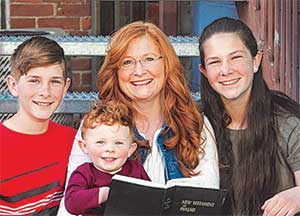November 2, 2022 – When Writing is a Chore


When Writing is a Chore
November 2, 2022
Deborah Wuehler
Writing Words or Writing Thoughts?
Hal and Melanie Young
Writing is Hard, But You Can Make It Easier
Beth Mora
The Teaching Strategy that Gets Missed: Talk Before You Write
Diane Heeney
Helpful Handwriting Hacks
| Be sure to scroll to the bottom to enter the contest and see the freebies of the month! |

Mercy Every Minute
Deborah Wuehler, TOS Senior Editor
Writing Words or Writing Thoughts?
Handwriting is putting words on paper, and writing is putting thoughts on paper. Both don’t happen at the same time or the same level. Having children write words and thoughts simultaneously, when they are not ready for both, can end in frustration.
Young students who can’t physically write yet (handwriting), can dictate or narrate back to you what you have read to them or what they have learned. Even non-readers can tell you what they heard, learned, or observed as you write their words down for them. Ask questions like, what happened; where and when? What did they see, hear, or feel? What did they learn? This frees up their mind to think (as they didn’t have to worry about the physical act of writing), and they are proud of their finished product.
To help with the physical act of handwriting, give very short assignments to copy. Handwriting will progress from there little by little every day until they become proficient. Have them copy good sentences from their literature, the Bible, poems, etc. This is called copywork.
As they get a bit older, I have the children write about the books they are reading, or paragraphs about their hobbies or interests, science discoveries, or poetry, personal letters, or devotional writing. In junior high and high school, we concentrate on essays and style.
Teaching writing (putting thoughts on paper) does not have to be difficult. We take it slow and easy, one step at a time. We brainstorm; we write; we think; we rearrange; we write some more. We get rid of “regular” words, use good synonyms, make arguments, and come up with strong endings. What we find out is that we do much more re-writing than actual writing. And we keep at it until it shines.
Need some more suggestions? Check out The Old Schoolhouse® Magazine to see some other tips for teaching writing.
Vibrant Writing by Karen Andreola
Writing Wrongs by Marlene Caroselli
Writing Across the Curriculum by TonyaAnn Pember
Besides copywork, we want to teach our children to copy their Heavenly Father. God is a writer. And what He has written is the best writing in the world. Have your children study Him! Why did He write? What did He write? To whom did He write? How can we write like Him?
Pray continually, and God will be faithful to show you the “write” way for each child. And whatever your child does, teach them to do it with the strength God provides, and for the glory of God Himself. He will bless their efforts and yours as you honor Him.
~Deborah

Raising Real Men
Writing is Hard, But You Can Make It Easier
When isn’t writing a chore? We’re full-time authors who support our family by writing, and it is still HARD work! There’s nothing as intimidating as a blank piece of paper (or a blank screen). In other words, don’t be surprised when your kids bellyache and complain about writing.
Don’t stop teaching them, though. Writing is one of those life skills that pretty much everyone needs—to write papers in college, reports for an employer, marketing materials for your business, for all kinds of things.
You can make writing easier, though:
Incorporate passion. The only time writing isn’t a chore for us is when we’re writing about something we’re passionate about. Scrap the boring prompts and get your kids writing about whatever it is that they love. Think about what they talk about alllll the time or the things they get outraged over. Those make great writing topics. Passion makes writing a breeze!
Don’t start with an outline—help them brainstorm first. Instead of beginning with, “Okay, what’s your first point?” (a guaranteed brain lock), write the topic in a middle of a piece of paper, and then add whatever comes to mind, creating a little cloud of ideas. Take time out to research a point if you need to. This creates what’s known as a concept map, and it allows brainstorming conversations to become more natural. Once it’s complete, it becomes clear what the major points should be—where the ideas cluster together! (Only then do you make an outline—if you must.)
Remove the obstacle of handwriting. There’s a difference between composing ideas into sentences and pushing a pen across paper. Sometimes kids hate writing because handwriting is still hard for them. Penmanship can be taught separately; if you want them to love composition, try letting them dictate or type. We’ve written nine books and haven’t written a single paragraph by hand. Don’t let handwriting interfere with composition!
Writing is hard work. There’s no way around that. It’s tough to compose your thoughts, formalize them into coherent sentences, and get them written out. Because it’s hard, most people avoid it. If you can raise your kids to press on through the effort, it will really pay off!
If they love reading, they’re more likely to want to write, too—download our free resource package to help your kids learn to love reading!
Your friends,
Hal & Melanie
About the author
Hal & Melanie Young are the award-winning, best-selling authors of Raising Real Men, No Longer Little, and Love, Honor, and Virtue. They are publishers, writers, bloggers, and popular conference speakers internationally, known for their Christ-centered focus and practical, real-life stories. They are the parents of six real boys (five grown!) and two real girls and live in noisy, messy happiness in North Carolina.

Beth Mora
The Teaching Strategy that Gets Missed: Talk Before You Write
Moans, groans, and nasty tones. No, this isn’t a creepy, spooky story around the campfire on a summer night. You just announced to your kids, “It’s time for writing.” You may have all the steps of the writing process neatly organized, but often home educators skip or skim through a vital teaching strategy when teaching writing. They avoid the talk. No, not “the talk.” I mean allowing your child to talk about what they will communicate through writing before grasping a pencil or pen.
It’s not just children; most writers, at some point in the writing process, must talk about the content of a report or story if they want to succeed as a writer. Even a businessman will speak with his colleagues before he writes a business proposal.
Implementing the “Talk Before You Write” teaching strategy has many benefits for a young writer:
- It helps your child shape their ideas and think about the order of their writing.
- It improves every step of the writing process, from brainstorming to publishing.
- Talking about their writing project will often reorient the direction of their writing, providing more clarity.
- One of the stellar benefits of talking about a writing project is that it helps a young writer discover different points of view. After all, in writing, there are many ways to express the same idea.
- And I think this is the best benefit of all; children LOVE it!
Above and beyond these benefits, the positive feelings your child will gain from talking it out before writing it out energizes the writing assignment!
You, as your child’s first editor, are in a privileged position to coach your child through their early writing assignments. Listening and asking great questions will help your child organize ideas and fall in love with writing. It’s a treasured time to learn more about your child’s heart and ideas.
Talking about their writing should not be optional for children; it is necessary! So, make ample time to include this powerful teaching strategy in your writing program! Please don’t avoid the talk.
About the author
Beth Mora, creator/teacher-on-camera for Here to Help Learning’s Homeschool Writing Program (grades 1-6) and homeschool conference and women’s events speaker, loves to blog at Home to Home. She serves up HTHL’s Writing Tip of the Week for those teaching their kiddos to write. Everything she does, whether laughable or heart gripping, is done to honor One. God’s grace is the salve that has healed her own life and is what she offers liberally to others.

Diane Heeney

Pillar of Faith
Diane Heeney – Helpful Handwriting Hacks
I love writing. It is fun and therapeutic for me. My kids, however, do not share my affinity for writing . . . not even a little. Here are some handwriting hacks that helped ease the burden of this part of our schooling.
- I don’t force cursive. I know there are varying opinions on this. In our house, I make sure the kids can read cursive and they have a decent signature, and we move on.
- Do evaluations to rule out contributing issues like dyslexia and dysgraphia.
- Try co-writing alongside your kids. That way they see and model your letter formation, spacing, alignment, and scale.
- Play secretary and let your child watch as you write a short story they dictate.
- Use good starter products like these pencil control exercises and these preschool journals.
- Use grip aids and chunky writing tools early on.
- Good pens make a difference. These write smooth and bold, and is affordable, with quick-drying ink.
- Choose copy work that is relevant to passions and interests. I promise—it pays off!
- I created our spelling lists from this relevant copy work. The goal of correct spelling was much more compelling when our kids were writing about things that mattered to them.



